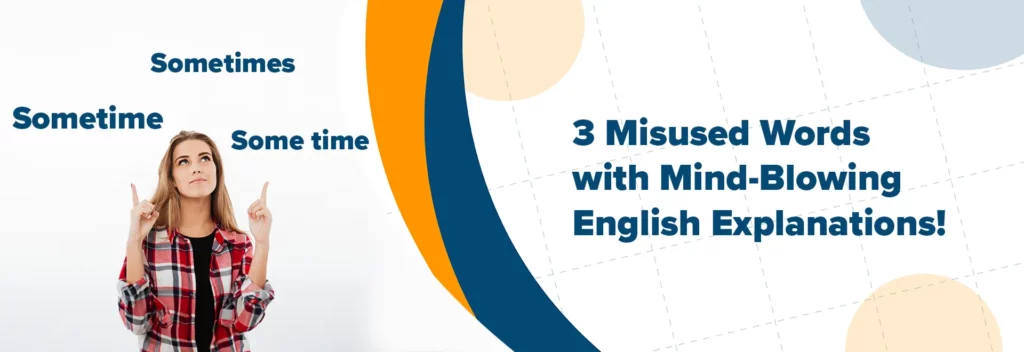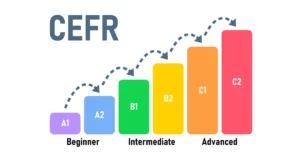
Sometime, Some time, Sometimes: 3 từ dễ gây nhầm lẫn trong tiếng Anh!
Giới thiệu
“Sam sometimes remembers sometime in the past as a sometime crew at McDonald’s for quite some time.”
Hơi bối rối phải không! Tuy nhiên, chúng có âm thanh giống nhau nhưng mục đích và chức năng khác nhau trong một câu. Để giải quyết sự nhầm lẫn này, QQEnglish cung cấp cho bạn kiến thức chuyên sâu về vấn đề này. cứ tiếp tục đọc và bạn sẽ tìm thấy những điều giá trị.
Một số từ có cách viết giống nhau nhưng khác nhau về nghĩa. Những từ này còn được gọi là Từ đồng âm —những từ có cùng cách phát âm và đánh vần nhưng có ý nghĩa, chức năng và nguồn gốc khác nhau. Nó có thể khá khó hiểu và ngay cả những người nói tiếng Anh bản xứ cũng mắc lỗi khi sử dụng những thuật ngữ này. Họ có thể bỏ qua cách viết của nó nhưng cần nhớ ý nghĩa chính xác. Tuy nhiên, không ai là hoàn hảo. Chúng ta vô tình mắc lỗi, đặc biệt là khi nói tiếng Anh.
Theo S. Kumphee trong nghiên cứu được thực hiện vào năm 2015 tại Đại học Công nghệ Suranaree, ông nói rằng việc mắc lỗi ngữ pháp khi viết là một trong những khó khăn chính đối với sinh viên học tiếng Anh như ngôn ngữ thứ hai (ESL) và tiếng Anh như ngoại ngữ (EFL). . Nhà nghiên cứu cũng cho biết thêm, ngôn ngữ mẹ đẻ của sinh viên trở thành một yếu tố dẫn đến vấn đề nêu trên.
Ngoài ra, việc hiểu từ đồng âm cũng là một trong những yếu tố ảnh hưởng đến việc sử dụng sai từ. Theo Hoffman & Tamm, năm 2020, ngay cả những người học ngôn ngữ mẹ đẻ và ngôn ngữ thứ hai cũng gặp phải vấn đề gần như giống nhau và việc mã hóa phụ thuộc vào ngữ cảnh trong các chức năng hệ thống ngữ nghĩa của não cũng như cách chúng ta xử lý những sự phức tạp này từ các từ đồng âm. Tuy nhiên, Elston-Güttler & Friederici cho biết cả hai đều có thể đạt được sự phân định trong nghiên cứu của họ vào năm 2007.
Tuy nhiên, những thuật ngữ này: sometime, some time, and sometimes là những từ bị sử dụng sai phổ biến nhất trong tiếng Anh. Nó giống như một đứa trẻ sinh ba mới sinh. Chúng có thể có những đặc điểm giống nhau nhưng chúng cũng có những điểm khác biệt và mục đích riêng biệt theo những cách độc đáo của riêng chúng.
Từ gây nhầm lẫn: Phân biệt và ví dụ về Sometime, Some time, và Sometimes
Chúng có âm thanh tương tự nhau nhưng chúng có ý nghĩa và cách sử dụng khác nhau trong một câu. Đó là lý do tại sao chúng ta phải cảnh giác với mục đích của nó trong câu. Ba từ: sometime, some time, and sometimes thuộc các loại khác nhau. Với điều này, chúng ta hãy phân biệt rõ hơn các từ bị sử dụng sai nói trên và đưa ra ví dụ về từng từ.
Sometime¹
Đây là cách diễn đạt gồm hai từ dùng để nói về một “khoảng thời gian” hoặc một khoảng thời gian dài hơn. Chúng ta không biết hành động diễn ra trong bao lâu nhưng chúng ta biết nó phải mất một thời gian dài. Nó cũng tương tự như cụm từ “for a while”. Chúng ta sử dụng cách diễn đạt này để chỉ một khoảng thời gian trong quá khứ, hiện tại và tương lai. Điều này cũng kéo theo sự không chắc chắn về khoảng thời gian được nêu.
Ví dụ:
1. “Let’s meet again sometime.”
Explanation: This sentence tells us that Person A is asking Person B to meet again soon but no exact time is mentioned.
2. “Come and revisit us sometime next month.”
Explanation: Person A here is requesting Person B to revisit them next month but it could be either in February, March, December, etc. as long as it’s next month.
3. “I’ll enroll in Fine Arts sometime this spring season!”
Explanation: This sentence entails that the person can enroll probably next year or next, as long as it falls to the Spring season.
4. “Sometime soon in January, we’ll get married.”
Explanation: The man assures the woman that they are going to get married in January regardless of what specific year in the future.
5. “The famous writer, a sometime science teacher, received a platinum award.”
Explanation: Before she got a platinum award for her writing skills which made her known, she was a science teacher then.
Hội thoại:
Andrei: Hello there, Ash! It was nice meeting you.
Ash: Thanks! Me, too.
Andrei: Let’s have a picnic sometime in the summer!
Ash: Great idea. How about in the park?
Andrei: Sure! That’s awesome. See you sometime in the summer!
Ash: Yeah, sometime soon!

Explanation: This conversation uses “sometime,” meaning they are having a plan to have a picnic at the park in the summer season. However, it is not stated to which year they are referring, yet they are sure that they are going to make it happen in the future.
Sometime²
Nó cũng có thể được sử dụng như một tính từ, có nghĩa là nó có thể mô tả một danh từ. Trong trường hợp này, nó chỉ là từ khác của “former” hoặc “previous”. Chúng ta dùng từ này để nói về một nhân vật cũ, một công việc trước đây, một việc gì đó mà người ta đã quen làm, v.v. nhưng nó không còn là sự thật ở hiện tại nữa.
Ví dụ:
1. “Danny, a sometime waiter at McDonald’s, works as a pilot now.”
Explanation: This means that Danny’s previous job was as a waiter at McDonald’s before he became a licensed pilot.
2. “Keith, a sometime bully in high school, became a priest 20 years later.”
Explanation: This sentence tells that Keith who is known for being a bully in high school when he was young became a priest when he got older. For a cause that such a turning point happened in his life that made him change.
3. “He is an engineer, a sometime famous carpenter in the town.”
Explanation: This one entails that before he became an engineer, he was once a famous carpenter in his town.
4. “Agatha, who was a sometime supervisor, is our CEO now!”
Explanation: The sentence tells that Agatha, who was a supervisor, became the CEO of the company as she is the daughter of the late CEO or she got promoted to a higher position.
5. “The famous writer, a sometime science teacher, received a platinum award.”
Explanation: Before she got a platinum award for her writing skills which made her known, she was a science teacher then.

Hội thoại:
Sam: Hello there, I have good news for you!
Troy: What is it?
Sam: Did you remember Alex? A sometime bully in high school?
Troy: Yes! What happened?
Sam: He is a well-mannered seaman now and has changed a lot.
Troy: Oh! I see. Tiffany, his ex-girlfriend, a sometime saleslady, is a model now, too!
Sam: Really? What a glow-up, man!
Explanation: The conversation uses the other word “sometime” which means “former.” Thus, they are talking about Alex’s character —a bully then, but a well-mannered seaman now— and Tiffany’s old job —a saleslady then, but a model now.
Some Time
Đây là cách diễn đạt gồm hai từ dùng để nói về một “khoảng thời gian” hoặc một khoảng thời gian dài hơn. Chúng ta không biết hành động diễn ra trong bao lâu nhưng chúng ta biết nó phải mất một thời gian dài. Nó cũng tương tự như cụm từ “for a while”. Chúng ta sử dụng cách diễn đạt này để chỉ một khoảng thời gian trong quá khứ, hiện tại và tương lai. Điều này cũng kéo theo sự không chắc chắn về khoảng thời gian được nêu.
Ví dụ:
1. “I think I have some time tomorrow morning.”
Explanation: This sentence tells us that he has plenty of time tomorrow in the morning but is not sure how long it will be.
2. “It took me some time to learn English.”
Explanation: The speaker says he didn’t learn English overnight. It took years, perhaps, to be able to speak it.
3. “It will take some time to wait for the supermarket to open.”
Explanation: The customer arrived too early at the supermarket.
4. “Tiara took some time to cry after dinner.”
Explanation: Tiara stayed in her room crying for a while.
5. “The athlete takes some time to relax after the game.”
Explanation: After a tiring game the athlete relaxes for a while but does not state how long he has been relaxing.
Hội thoại:
Zack: Hey, Joe! What are your plans for this weekend?
Joe: I am going to take some time walking on the beach. How about you?
Zack: Well, I was going to take some time to relax after having exercises this morning.
Joe: Are you free next Sunday?
Zack: Yes! I have some time on Sunday next week.
Joe: Then, let’s have some time watching a movie together.
Zack: Good idea!

Explanation: This conversation has the phrase “some time” which means they are talking about a length of time. Although it is not stated how long it was, for they are uncertain, surely their free time is longer than a minute.
Sometimes
Từ này là một Trạng từ chỉ tần suất được sử dụng với thì hiện tại đơn của động từ nhưng không thường xuyên như luôn luôn cũng không hiếm khi như không bao giờ, chỉ ở giữa. Đó là năm mươi phần trăm (50%), nếu không thì ngược lại. Chúng ta sử dụng trạng từ này để diễn tả việc thỉnh thoảng chúng ta làm việc gì đó vào một thời điểm nào đó. Một số Trạng từ chỉ tần suất luôn luôn, thường, hiếm khi, hiếm khi, không bao giờ và nhiều trạng từ khác. Hơn nữa, từ này có thể được đặt ở đầu, giữa và cuối câu mà không làm thay đổi ý chính của nó.
Ví dụ:
1. “Sometimes, Jane forgets to bring her wallet.”
Explanation: This sentence follows the beginning format, wherein ‘sometimes’ is placed as the first word in the sentence and is always followed by a comma. Moreover, it means that Jane most of the time forgets to bring her wallet when she wants to go out.
2. “Ericka sometimes gets to school late.”
Explanation: This sentence uses the middle format of the adverb placements, which is IN the sentence now. This also means that every week, there are chances that she’ll be late i.e. She’s going to be late on Mondays and Tuesdays due to traffic.
3. “Margarette drinks beer sometimes.”
Explanation: Notice that the word ‘sometimes’ is in the last part of the sentence as it follows the ending of the adverb placement pattern. This means that Margarette drinks beer on Saturdays or twice a month.
4. “Julia and Beth sometimes fight over a boy.”
Explanation: This one follows the middle pattern and it entails that Julia and Beth’s reason for their conflict is about a boy they had a crush on.
5. “She’s intelligent but quite arrogant sometimes.”
Explanation: The word ‘sometimes’ appears in the last part of the sentence because it follows the ending pattern. It also means that this girl is truly intelligent but there are times that she’s overly confident to the point that she will look down on others.

Hội thoại:
Bruce: Hello, Will! How’s life going?
Will: It’s fine but quite hard sometimes. How about you?
Bruce: Lee and I sometimes go to Disneyland and travel to different places.
Will: Oh! That’s wonderful. Sometimes, I envy you both.
Bruce: Why is that so?
Will: Well, Liam and I are separated now. We can’t travel together anymore.
Bruce: Too bad. Oh! You can get along with us sometimes.
Will: Thanks a lot!
Explanation: They are talking about how often things have happened in the past, are still happening in the present, and will happen to them in the future. As you can see, the word sometimes appears in three different placements but the thought is still the same.
Lưu ý!
Việc lựa chọn từ ngữ phù hợp khi đặt câu có thể tạo ra tác động tốt trong giao tiếp. Đặc biệt, khi nói đến những từ có cách viết giống nhau hoặc gần như khác nhau về nghĩa, chẳng hạn như những từ thường bị sử dụng sai: sometime, some time, and sometimes, đó là chủ đề chính của chúng ta. Điều quan trọng là phải chú ý đến cách sử dụng các từ có cách viết tương tự một cách tốt và chính xác để tránh nhầm lẫn và hiểu lầm.



